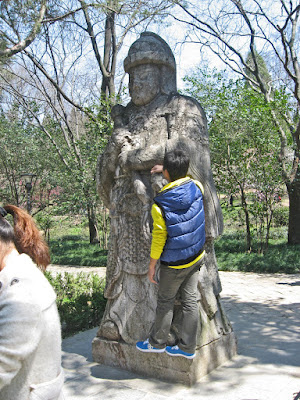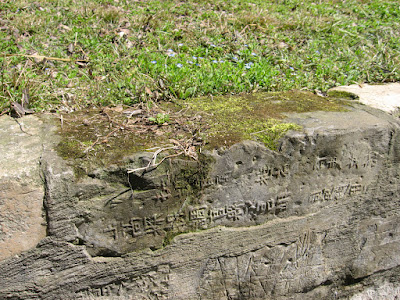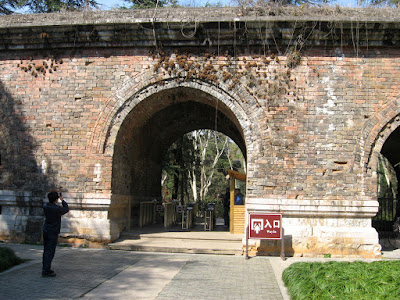Sunday, March 24, 2012
As a way to see the plum blossoms in Nanjing, we had to go to the Ming Xiao Ling/Ming Tomb. The Ming Dynasty began with its capital in Nanjing. The capital was moved to Beijing by the third Ming emperor, and the rest of the Mings were buried at the Beijing Ming Tombs. However, the first Ming emperor, the Hongwu Emperor Zhu Yuanzhang, was buried at this Ming Tomb, thus it is the oldest and first Ming Tomb.We started following the Spirit Way/Sacred Way in the middle, at the Hua Biao/decorative hexagonal columns:
But first some snacks for lunch: a meat stick, a red bean sticky bun, and some fresh strawberries:
Others were trying the caramel art lollipops:
The artist drizzles the hot caramel on a marble surface in a design, then when it hardens, carefully lifts it up:
This was a rooster lollipop.
Back on the Sacred Way, where it turns north. Different from the straight sacred ways of former dynasties, this one turns and curves, making it unique and unprecedented in Chinese history. Here it is lined with two pairs of generals:
(It looks like they stick juniper branches in the ground, but they are all rooted:)
And two pairs of civil servants in 14th-century dress:
This one stands in front of Plum Blossom Hill:
The last pair of civil servants stands before the Pailou/decorative gateway.
The Lingxing Men/Dragon & Phoenix Gate (renovated in 2006) has six pillars and three openings:
The tops of the pillars are carved to look like clouds.
Kent at a side bridge over a series of pools:
Three bridges make up the Jin Shui Qiao/Golden Waters Bridge:
This begins the straight path to the mausoleum.
A group of tourists, this one with orange caps:One tour group had matching Burberry-like rain hats.
Wenwu Men/Civil & Military Gate:
Restored in 1998.
Just before the gate sits a tablets with a Special Notice written in six languages:
Erected in 1909, the languages are English, Japanese, French, German, Italian, and Russian.
Imperial Tablet Hall:
First restored in 1699 when then Qing Emperor Kangxi wrote these four characters. Somehow these four characters say "Running the State even better than the Tang Emperor Taizong and Song Emperor Taizu, two successful emperors in Chinese history."
The tablet is held by the Bixi:
Bixi is the eldest son of the dragon, with the body of a tortoise and head of a dragon. He is able to carry very heavy loads. And it said in plain English that he was not to be touched:
But who can see the sign through the crowds of people:
An ornate stone relief carving:
Bixi's rear end:
I guess it's lucky to rub that end, too.
The three-level base of Xiaoling Hall:
Xiaoling or Sacrificial Hall:
It was originally built in 1383 for the memorial tablets of the emperor, his wife and concubines. The present reconstruction now houses a gift shop, and is much smaller in scale than the original. Around the outside you can see the bases of many columns.
After passing through an Inner Red Gate, you can see the massive Soul Tower:
It is built on top of a rectangular citadel, and was restored in 2009. This tower allows the souls buried in a mound behind it, to rise to heaven.
Individual bricks were marked by the manufacturer to insure quality control:
A couple of root canals:
Well Pavilion:Tamiko with a tree trunk that looks like animal legs and toes:
Back on the Sacred Way, a girl tries a rolling hoop toy:
This time we head away from the mausoleum on the Sacred Way, passing the stone carved animals. There are two pairs of each animal, one pair standing and one pair sitting.
First the loyal horses:
Then the Chinese mythical creature, the Qilin, with scaly skin and cloven hooves:
Legend states the Qilin appeared only during the reign of a benevolent and wise emperor.Next the elephants and camels:
Kent took off into an area to one side, where the Spring Outing Festival was underway:
Jolly jumpers for big kids:
Big inflatable pool for the hand-paddle boats:
A lane of very tall sycamore trees:Another Chinese mythical creature, the Xiezhi:
Sort of a lion with a horn and hooves.
Sifengchang/Four Square Pavilion:
This building has lost its roof, but still has Bixi holding a tablet:
This tablet was inscribed in 1413 by Zhu Yuanzhang's son, who needed 2,746 characters to describe the merits of the emperor.
Wedding photography:A road interrupted the Sacred Way:
Dajin Men/Great Golden Gate/Dismounting Gate:
The entrance to the Ming Xiaoling/Ming Tomb.














































No comments:
Post a Comment